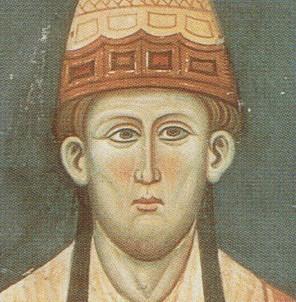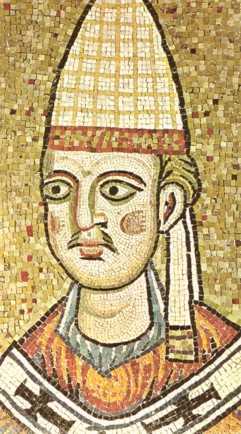
[Maxwell-Stuart (1997) 83]

[Bovini (1966) 19]
 |
|
[Maxwell-Stuart (1997) 83] |
 |
|
[Bovini (1966) 19] |
Pope Innocent III (1198-1216), is generally considered to be “the greatest pope of the Middle Ages, who came near to establishing pontifical theocracy.” [Dunan (1968) 323.] Innocent was a man of strongly Nordish racial descent. He was born in the Castello di Gavignano in Campagna di Roma, and bore the distinctly Germanic name Lotario (= Lothar). Innocent’s father was the Italian aristocrat Trasimund, Count of Segni, and his mother, Claricia Scotti, came from the Roman nobility. Both families were of Germanic ancestry. [Woltmann (1905) 37.] Innocent’s family was extremely distinguished, as one author has noted: “Innocent III came from a family, the Conti, which, over a period of some 500 years, gave the Church 13 popes, 3 antipopes, 40 cardinals and a queen.” [Maxwell-Stuart (1997) 101.]
In the Conti Chapel at Poli in Latium, there resides the remains of a thirteenth-century mosaic, that formerly adorned the apse of the old Basilica of St. Peter in Rome. [Bovini (1966) 23-4.] The mosaic was restored by Innocent during his pontificate, and one fragment that has survived, depicts him with blond hair and a fair complexion. Unfortunately, the racial import of this artwork is marred somewhat by its relatively crude nature.
However, a more valuable contemporary depiction of Innocent can be found in the Church of Sacro Speco at Subiaco. A thirteenth-century fresco of Innocent can be found there, which portrays him in great detail. [Maxwell-Stuart (1997) 101.] The fresco shows Innocent as an imposing figure, with a long face, narrow nose, and a lantern jaw. His complexion is pale, but ruddy in the cheeks; his hair is dark-blond, though shot through with light-blond highlights; his eyes are dark-blue in colour. It may be deduced from all of the foregoing evidence, that Innocent III was predominantly Nordish.
Bovini, G. (1966) The Basilica of St. Peter, Rome (Bologna: Resto del Carlino).
Dunan, M. (1968) Larousse Encyclopedia of Ancient and Medieval History (Feltham: Paul Hamlyn).
Maxwell-Stuart, P. G. (1997) Chronicle of the Popes (London: Thames & Hudson).
Woltmann, L. (1905) Die Germanen und die Renaissance in Italien (Leipzig: Thüringische Verlagsanstalt).